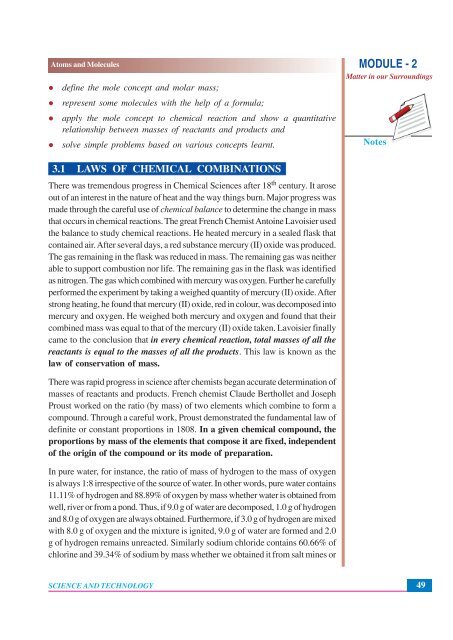Create successful ePaper yourself
Turn your PDF publications into a flip-book with our unique Google optimized e-Paper software.
Atoms and Molecules<br />
<br />
<br />
<br />
<br />
define the mole concept and molar mass;<br />
represent some molecules with the help of a formula;<br />
apply the mole concept to chemical reaction and show a quantitative<br />
relationship between masses of reactants and products and<br />
solve simple problems based on various concepts learnt.<br />
MODULE - 2<br />
Matter in our Surroundings<br />
Notes<br />
3.1 LAWS OF CHEMICAL COMBINATIONS<br />
There was tremendous progress in Chemical Sciences after 18 th century. It arose<br />
out of an interest in the nature of heat and the way things burn. Major progress was<br />
made through the careful use of chemical balance to determine the change in mass<br />
that occurs in chemical reactions. The great French Chemist Antoine Lavoisier used<br />
the balance to study chemical reactions. He heated mercury in a sealed flask that<br />
contained air. After several days, a red substance mercury (II) oxide was produced.<br />
The gas remaining in the flask was reduced in mass. The remaining gas was neither<br />
able to support combustion nor life. The remaining gas in the flask was identified<br />
as nitrogen. The gas which combined with mercury was oxygen. Further he carefully<br />
performed the experiment by taking a weighed quantity of mercury (II) oxide. After<br />
strong heating, he found that mercury (II) oxide, red in colour, was decomposed into<br />
mercury and oxygen. He weighed both mercury and oxygen and found that their<br />
combined mass was equal to that of the mercury (II) oxide taken. Lavoisier finally<br />
came to the conclusion that in every chemical reaction, total masses of all the<br />
reactants is equal to the masses of all the products. This law is known as the<br />
law of conservation of mass.<br />
There was rapid progress in science after chemists began accurate determination of<br />
masses of reactants and products. French chemist Claude Berthollet and Joseph<br />
Proust worked on the ratio (by mass) of two elements which combine to form a<br />
compound. Through a careful work, Proust demonstrated the fundamental law of<br />
definite or constant proportions in 1808. In a given chemical compound, the<br />
proportions by mass of the elements that compose it are fixed, independent<br />
of the origin of the compound or its mode of preparation.<br />
In pure water, for instance, the ratio of mass of hydrogen to the mass of oxygen<br />
is always 1:8 irrespective of the source of water. In other words, pure water contains<br />
11.11% of hydrogen and 88.89% of oxygen by mass whether water is obtained from<br />
well, river or from a pond. Thus, if 9.0 g of water are decomposed, 1.0 g of hydrogen<br />
and 8.0 g of oxygen are always obtained. Furthermore, if 3.0 g of hydrogen are mixed<br />
with 8.0 g of oxygen and the mixture is ignited, 9.0 g of water are formed and 2.0<br />
g of hydrogen remains unreacted. Similarly sodium chloride contains 60.66% of<br />
chlorine and 39.34% of sodium by mass whether we obtained it from salt mines or<br />
SCIENCE <strong>AND</strong> TECHNOLOGY<br />
49
















